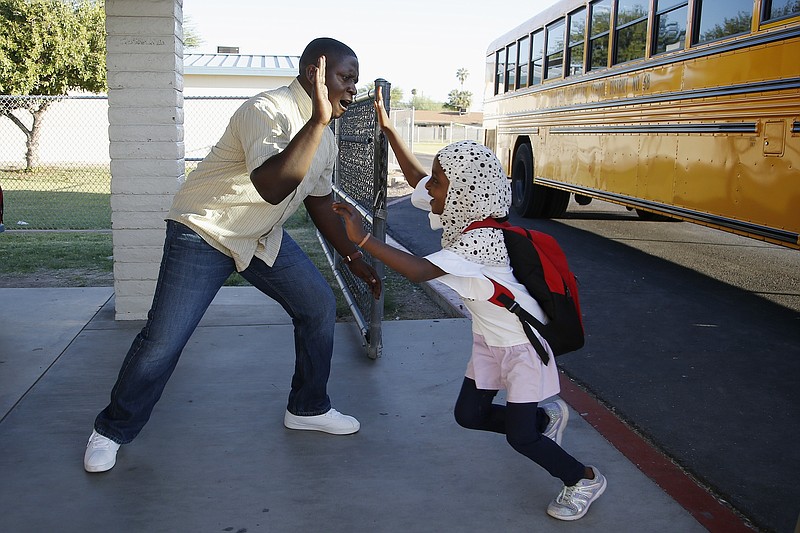PHOENIX (AP) — International flags flutter from the ceilings of the outdoor hallways at Valencia Newcomer School, where more than 200 children from around the world are learning English skills and American classroom customs they need to succeed.
When the school year begins, the refugee and immigrant children often don’t know the rules. A child might be fascinated with a light switch they excitedly turn off and on. Another is startled by a whistle or a helicopter buzzing overhead that recalls conflict back home.
But fears melt away as the children adjust, said Valencia Principal Lynette Faulkner, who calls the school their “safe place.” Soon, they stand in line, raise their hand, keep their feet on floor. As they learn English, students make friends across cultures.
Since fall 2018, the public school has welcomed students from countries including Myanmar, Eritrea, Indonesia, Afghanistan and Cuba for an extra year of attention before transferring to mainstream schools. This year’s kindergarten through eighth-grade students come from 21 countries and speak 15 languages.
Valencia is among a handful of U.S. public schools dedicated to helping some of the thousands of children who arrive in the country each year, even as the Trump administration has proposed pushing down the annual cap for refugees to a historic low of 18,000. No refugees were settled in the U.S. last month.
The schools aren’t necessarily in cities with more refugees, but where local education officials took the initiative to create them. Similar schools are in Indianapolis; Houston; Fort Worth, Texas; Greensboro, North Carolina; and Providence, Rhode Island.
Arizona ranks eighth among states for refugee resettlement. The number plunged from 4,110 people in fiscal year 2016 to 998 in 2018, then rose slightly to 1,216 for the 12-month period that ended Sept. 30. About half are children.
Gov. Doug Ducey hasn’t weighed in yet on President Donald Trump’s executive order allowing states and cities to reject refugees. At least five states have signaled they will accept refugees, and no governor has said they plan to keep them out. Several agencies sued last week seeking to halt the order.
“There may be less, but they’re still coming,” Valencia teacher Kristine Jones said. “And we have to be there for them, whether it’s academically or getting them services like immunizations.”
It’s unclear if the lower cap on refugees will affect already limited funding for school districts from the Office of Refugee Resettlement’s Refugee School Impact Program.
The Arizona Department of Economic Security last year distributed about $635,000 to help 1,026 school-age refugees statewide with things like interpretation, tutoring and school supplies.
Immigrants and other children newly arrived from abroad can attend newcomer schools if they need help with basic English, including those born in the U.S., taken out of the country and returned.
“As long as you have kids struggling with English, there will always be a place for these kinds of programs,” said Deborah Short, a Washington-based English learning specialist who has written about newcomer education. She noted some mainstream schools have newcomer classrooms.
There are often huge challenges for children who trudged across several countries, lived in camps or witnessed extreme violence.
Refugee and other immigrant children who lose a home or parent can suffer from toxic stress, a term used by child development experts for the body’s response to long-term adversity, said Sarah Smith, senior director of education for the nonprofit International Rescue Committee.
“Infants might cry for long periods of time,” Smith said. “Children in school might have a hard time concentrating.”

